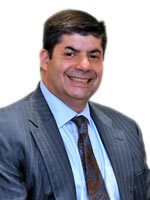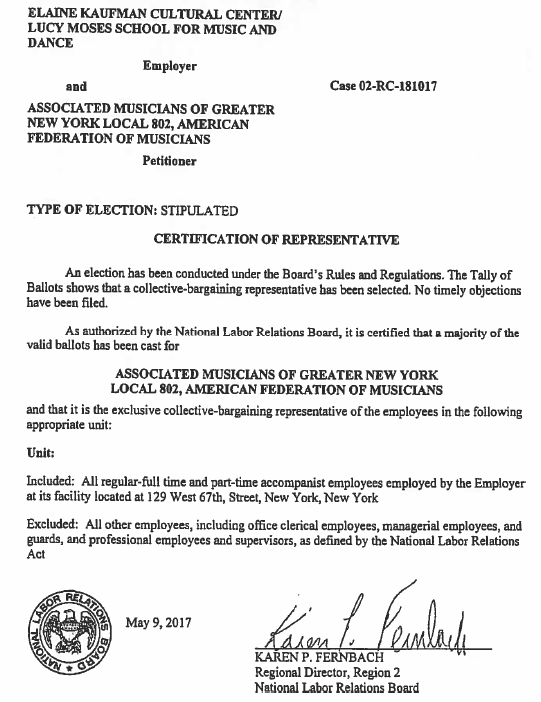Allegro
An Inside Look at a Local 802 Organizing Campaign
Legal Corner
Volume 119, No. 2February, 2019

Harvey Mars, Esq.
Harvey Mars is counsel to Local 802. Legal questions from members are welcome. E-mail them to HsmLaborLaw@HarveyMarsAttorney.com. Harvey Mars’s previous articles in this series are archived at www.HarveyMarsAttorney.com. (Click on “Publications & Articles” from the top menu.) Nothing here or in previous articles should be construed as formal legal advice given in the context of an attorney-client relationship.
Many unions have lost sight of the importance of organizing. Without the influx of new members, a union’s vitality can atrophy and ultimately can become severely compromised because of attrition and lack of union density. A union’s strength lies in its members. The greater its membership rolls, the greater a union’s strength and bargaining leverage. The loss of membership can cripple an otherwise powerful and successful union.
Nevertheless, organizing new bargaining units is an extremely arduous and laborious process. The legal and political landscape in which organizing must now take place creates a huge hurdle. This may be in part an explanation why some unions simply focus on servicing and maintaining existing bargaining units rather than attempting to increase membership rolls. Local 802 has been no exception to this. Successful organizing campaigns that have resulted in beneficial union agreements have been sparse recently. But there has been some good news: several new bargaining units have been created. One new unit is comprised of the accompanists employed by the Kaufman Center. (See accompanying story in this issue.) The organizing process and subsequent legal proceedings before the National Labor Relations Board that ultimately resulted in a bargaining order and first-time collective bargaining agreement for this group of musicians provides great insight into just how difficult an endeavor this can be. Before delving into that topic, it is beneficial to understand the context in which union organizing can take place.

Nine months after an appeal, Local 802 won an organizing decision from the NLRB.
The anatomy of an organizing campaign can vary considerably from industry to industry. Several approaches may be employed. One is where a union’s organizing department targets employers whose workers fit within pre-existing employment sectors, such as home care and day care. Union organizers get workers to sign union authorization cards, which are required by the National Labor Relations Board to secure a union certification election. Employees must be convinced of the benefits of joining a union. I witnessed this approach being utilized by social service unions such as AFSCME. It can be successful for low wage employees who lack job and income security. Unfortunately, it has little success with skilled or highly educated employees.
Another approach is where an employer contacts the union directly and seeks to engage in negotiation for a labor agreement that would cover its employees. Most often those employers participate in bargaining unit work themselves and are motivated by the desire to receive union benefits. The problem with this approach is that their employees may not wish to participate in the negotiation and the result is a weak agreement. Further, without proof of union majority status, the bargaining relationship can be challenged at any time.
The Kaufman accompanists were organized through yet a third approach. The accompanists themselves contacted the union and sought its assistance in mounting an organizing campaign. Several accompanists who were also covered by an existing union agreement between Local 802 and the Kaufman Center saw the disparity in treatment between the accompanists and the unionized teaching artists. These employees, with the union’s assistance, engaged in an organizing process that resulted in a majority of the accompanists choosing Local 802 as their exclusive collective bargaining agent. This bottom-up approach can be the most successful because it creates a cohesive group of workers that is more resistant to an employer’s efforts to short-circuit the campaign. The nucleus of this group can also serve as the union bargaining committee. This is precisely what happened in this instance and created a unified group that was able to stay the course until negotiations were completed.
To say that the road that led to the ratification of a collective bargaining agreement covering the accompanists was an easy one to traverse would be a gross understatement. Nothing was easy about the process, though the union sought to take the path of least resistance. Once we secured majority support, we proposed to the Kaufman Center that the accompanists be included in the bargaining unit covered by the pre-existing teaching artist unit. Management promptly rebuffed that proposal – which they legally could – since parties are not required to negotiate over the composition of bargaining units.
Once we discovered that legal proceedings before the NLRB to include the accompanists in the existing agreement would become protracted because of resistance from the employer, Local 802 decided to file an election petition for a separate bargaining unit. The consequence of this is that we would have to negotiate over a completely new collective bargaining agreement rather than utilize one that already existed. Kaufman Center and Local 802 voluntarily agreed to a bargaining unit consisting of all regular full time and part time accompanists employed by the Eemployer at its facility located at 129 West 67th Street. Then, in an unusual move, we agreed to create a list of accompanists who would be deemed eligible to vote. This is known as a Norris-Themador list. However, one employee who the union insisted including on the list was opposed to by the Kaufman Center because they allegedly were used sporadically on a substitute basis. Under NLRB regulations, the issue of whether this employee should be in the unit was reserved until after the trial if they had cast the deciding vote. The issue of whether the challenged ballot could be opened and counted was reserved until after the election.
The election proceeded and quite ironically, the challenged employee had in fact cast the deciding vote. An even number of accompanists had voted both for and against union certification. As a result the NLRB regional director decided that a hearing had to be conducted to determine whether inclusion was warranted. A hearing took place over the course of several days and the presiding NLRB hearing officer determined that the challenged ballot should not be opened because the challenged employee was not “regularly employed” as an accompanist. Since a majority had not cast their ballot in favor of certification, the union’s petition was dismissed.
Local 802 appealed the hearing officer’s decision to the regional director and the decision was reversed because the stipulated bargaining unit consisted of any employee who had performed accompanist services, regardless of the frequency and length of their service. An order was entered mandating that the ballot be opened. However, the saga did not end there. The Kaufman Center appealed the regional director’s decision to the full National Labor Relations Board. On Nov. 29, 2017, some nine months after the appeal was submitted, in a published decision the NLRB upheld the regional director’s decision. Almost a year after the election had occurred, the challenged ballot was finally opened and fortunately, it was a yes vote. Local 802 was finally certified as the exclusive bargaining representative for the accompanists.
Negotiations proceeded and after several additional months, a collective bargaining agreement was negotiated. This agreement features a 24 percent increase in wages and benefits that accompanists had long sought for. Finally, they were being recognized as part of the faculty, rather than as contingent labor.
To put this process in context, the stipulated election agreement was entered into in August 2016. The collective bargaining agreement was executed in December 2018. Much of the elapsed time was due to legal wrangling over the challenged ballot. Nonetheless, because organizing occurred in a bottom up fashion which resulted in a unified, cohesive group of employees, we were able to achieve a first time contract that we were proud to sign. The lesson here is that the means by which employees are organized can have a huge impact on whether a collective bargaining agreement can be achieved. Our challenge now is to create an environment where musicians seek out the union to organize new bargaining units rather than the converse.
